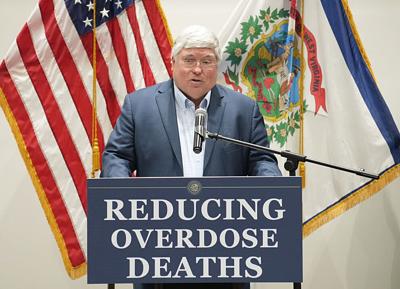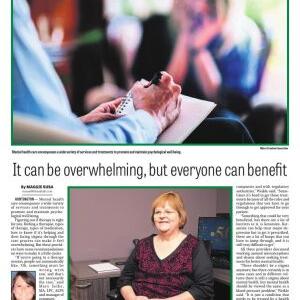“““Į╩ėŲĄ West Virginia records the largest reduction in fatal overdoses across the nation over a 12-month period, substance use disorder and encouraging the state to continue, while also increasing, the services available to people who use drugs.
from the Centers for Disease Control and Prevention, West Virginia has seen two months of declines in the annual rate of fatal overdoses, representing a 41% decrease compared to deaths reported in both preceding 12-month periods.
The drop is decidedly good news for the state, which has for years been referred to as “““Į╩ėŲĄ£ground zero“““Į╩ėŲĄØ for the nation“““Į╩ėŲĄÖs ongoing drug and overdose epidemic.
But even while celebrating, experts say it“““Į╩ėŲĄÖs important to ensure the context and circumstances surrounding the decline is taken into account.
“““Į╩ėŲĄ£Two months is not a lot of time,“““Į╩ėŲĄØ said Michael Meit, director of the Center for Rural Health and Research at East Tennessee State University. “““Į╩ėŲĄ£You need to make sure that trend continues and, if it does “““Į╩ėŲĄö which we all hope it will “““Į╩ėŲĄö that“““Į╩ėŲĄÖs when you“““Į╩ėŲĄÖll know that the systems in place are working in a positive way.“““Į╩ėŲĄØ
The data from the CDC represents overdose deaths recorded between January 2024 and January 2025, the most recent data available for analysis by the agency. The numbers are provisional and could increase as more deaths are analyzed.
According to the data, West Virginia so far has confirmed 787 deaths in that 12 month period. Between January 2023 and 2024, per the data, the state saw 1,351 residents die from overdoses.
Meit, who is also an associate professor in ETSU“““Į╩ėŲĄÖs Department of Health Services Management and Policy, said there are several factors that could contribute to the state successfully curbing fatal overdose rates. Crucial context for the decline, he said, is how rates of both substance use and fatal overdoses related to that use increased so much during the pandemic.
In 2020, 1,343 West Virginians died from fatal overdoses “““Į╩ėŲĄö setting a new record for the state. In 2021, deaths increased again to 1,537, from the state health department. The trend in the state reflected what was happening nationally; overdoses “““Į╩ėŲĄö fatal and otherwise “““Į╩ėŲĄö increased nearly everywhere while the COVID-19 pandemic unfolded.
In 2022, and 2024, overdose deaths in West Virginia dropped consecutively each year, per the data.
Now, Meit said, it“““Į╩ėŲĄÖs likely conditions are evening out. The record decline could, at least in part, reflect this.
“““Į╩ėŲĄ£I hope we“““Į╩ėŲĄÖre turning a curve, but I“““Į╩ėŲĄÖm a little bit of a skeptic at heart. West Virginia leading the nation [in the decline] implies that West Virginia is doing better than other places in addressing these issues. So I do think that it“““Į╩ėŲĄÖs not just a blip, but there are other things to consider,“““Į╩ėŲĄØ Meit said. “““Į╩ėŲĄ£I am concerned that a lot of the declining overdose rates that we are seeing now “““Į╩ėŲĄö a partial factor is what we call a return to baseline. So we are essentially getting back to where we were pre-pandemic.“““Į╩ėŲĄØ
The fatalities reported between January 2024 and 2025 are the lowest recorded in the state since 2015, when 735 people died from overdoses. At the time, that was the highest number reported by West Virginia in one year since 2001, when the state started tracking and reporting overdose deaths.
Dr. James Berry, who serves as chair for the Department of Behavioral Medicine and Psychiatry at West Virginia University“““Į╩ėŲĄÖs Rockefeller Neuroscience Institute, said he was “““Į╩ėŲĄ£encouraged“““Į╩ėŲĄØ to see declines in the state. But like Meit, he“““Į╩ėŲĄÖs cautious about assuming the declines will continue without further work, especially given where West Virginia still stands nationally.
“““Į╩ėŲĄ£This decline means so many more lives will continue to exist because of efforts that have been going on in the state. At the same time, in West Virginia, we still lead the nation by far in the rates of overdose deaths,“““Į╩ėŲĄØ Berry said. “““Į╩ėŲĄ£We“““Į╩ėŲĄÖve had a wonderful decline, but still I don“““Į╩ėŲĄÖt think people appreciate how far above we are other states [in the rate of fatal overdoses], above the national average. So we still have a very, very long way to go.“““Į╩ėŲĄØ
“““Į╩ėŲĄśWe have to keep our foot on the pedal“““Į╩ėŲĄÖ
Gov. Patrick Morrisey in overdose deaths during a news conference in Princeton on Wednesday. In a release after, he said the state is “““Į╩ėŲĄ£setting the standard for successfully battling addiction and saving lives.“““Į╩ėŲĄØ
“““Į╩ėŲĄ£Our nation-leading reduction in overdose deaths is the result of a holistic approach to tackle drug use and abuse,“““Į╩ėŲĄØ Morrisey said. “““Į╩ėŲĄ£We will continue to work hard together to prevent further senseless death in West Virginia.“““Į╩ėŲĄØ
Meit has spent a lot of time , specifically, lead communities to decreasing or increasing their overdose rates. One of his studies , a region both culturally and economically reminiscent of West Virginia“““Į╩ėŲĄÖs southern coalfields.
West Virginia“““Į╩ėŲĄÖs coalfield counties continuously lead the state “““Į╩ėŲĄö as well as the nation “““Į╩ėŲĄö in the rate of fatal overdoses. Not long ago, the counties in eastern Kentucky did the same.
But something happened in the 2010s that turned the tide in Kentucky.
Between 2012 and 2017, eight of the top 10 counties in the nation with the steepest decrease in overdose mortality were clustered in eastern Kentucky.
“““Į╩ėŲĄ£What we found was a big investment in addressing the substance use crisis “““Į╩ėŲĄö in establishing harm reduction programs throughout the state, making sure they had treatment beds available, paying for treatment, engaging their criminal justice system,“““Į╩ėŲĄØ Meit said. “““Į╩ėŲĄ£These declines were studied over a 10 year period before the pandemic; we know it wasn“““Į╩ėŲĄÖt just a blip “““Į╩ėŲĄö it was a direct response to the systems in place.“““Į╩ėŲĄØ
Kentucky today, Meit said, has the most harm reduction sites of any state in the country. Most offer syringe service programs. The state also has the highest number of residential treatment beds and its Medicaid program includes a dedicated benefit for receiving substance use disorder treatment.
The environment in West Virginia, however, is much different.
Harm reduction programs are few and far between. Needs-based syringe service programs “““Į╩ėŲĄö which at preventing disease among people who use drugs as well as transitioning people into recovery “““Į╩ėŲĄö are banned at the state level. There“““Į╩ėŲĄÖs a , especially in the regions hardest hit by the drug epidemic. There“““Į╩ėŲĄÖs been a moratorium on establishing new methadone clinics in the state for years, meaning the medication “““Į╩ėŲĄö at helping people overcome opioid use disorder “““Į╩ėŲĄö isn“““Į╩ėŲĄÖt available to most.
The current recovery and rehabilitation environment in West Virginia can largely be attributed to policies adopted by the state Legislature over the last decade. In the last several years, by the body that reflect “““Į╩ėŲĄ£best practices“““Į╩ėŲĄØ for addiction and recovery; instead on the criminalization of substance use disorder and the people who live with it.
Berry has worked in West Virginia studying and treating substance use disorder since 2002. He“““Į╩ėŲĄÖs watched firsthand as the nature of the epidemic has shifted from prescription drug use to heroin use to, most recently, fentanyl. Each time, as new drugs have come into communities, overdoses have increased alongside increased use.
Berry has also watched how policies have evolved “““Į╩ėŲĄö or, in several ways, devolved “““Į╩ėŲĄö in response to the changes in the nature of the epidemic.
It“““Į╩ėŲĄÖs likely, Berry said, that the decreases being celebrated this month in West Virginia reflect “““Į╩ėŲĄ£the bearing of fruit that were the labors put in place, five to 10 years ago.“““Į╩ėŲĄØ
Those “““Į╩ėŲĄ£labors“““Į╩ėŲĄØ include , efforts to destigmatize addiction, recruiting health care workers with specific expertise on substance use disorder, increasing access to treatment programs as well as beds and an emphasis on educating both the public and providers about the disease.
Berry is slightly concerned that the successes being celebrated this month could mean a decreased focus by lawmakers on interventions that are working. To step back now, he said, would threaten future success.
“““Į╩ėŲĄ£It“““Į╩ėŲĄÖs so encouraging that we“““Į╩ėŲĄÖve got some traction. After so many years of going in the wrong direction, we finally have some traction but we have to keep our foot on the pedal and keep going forward,“““Į╩ėŲĄØ Berry said. “““Į╩ėŲĄ£If we don“““Į╩ėŲĄÖt do that, if we don“““Į╩ėŲĄÖt keep looking at what more we can do, then I really fear that we“““Į╩ėŲĄÖre going to start getting worse again.“““Į╩ėŲĄØ













